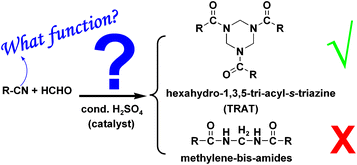RDX (hexahydro-1,3,5-trinitro-s-triazine) is a rocket propellant but its manufacture comes with high risk of explosion.
Ke-Li Han from the Dalian Institute of Chemical Physics, China, and colleagues have used a computational study to gauge which parts of the synthesis of the RDX precursor TRAT (hexahydro-1,3,5-triacetyl-s-triazine) are most likely to cause an explosion.
They found that of the four stages in the synthesis – imine formation, amino methylation, dehydration and trimerisation – the second and fourth stages are the most likely to release energy in the form of an explosion. The team suggests that more attention is paid to these stages of production.
The full article is free to access upon a simple registration process.
A reaction of formaldehyde with acetonitrile: understanding the preparation of RDX (I), X-F Chen, B-Z Wang and K-L Han, RSC Adv., 2011, DOI: 10.1039/c1ra00239b











